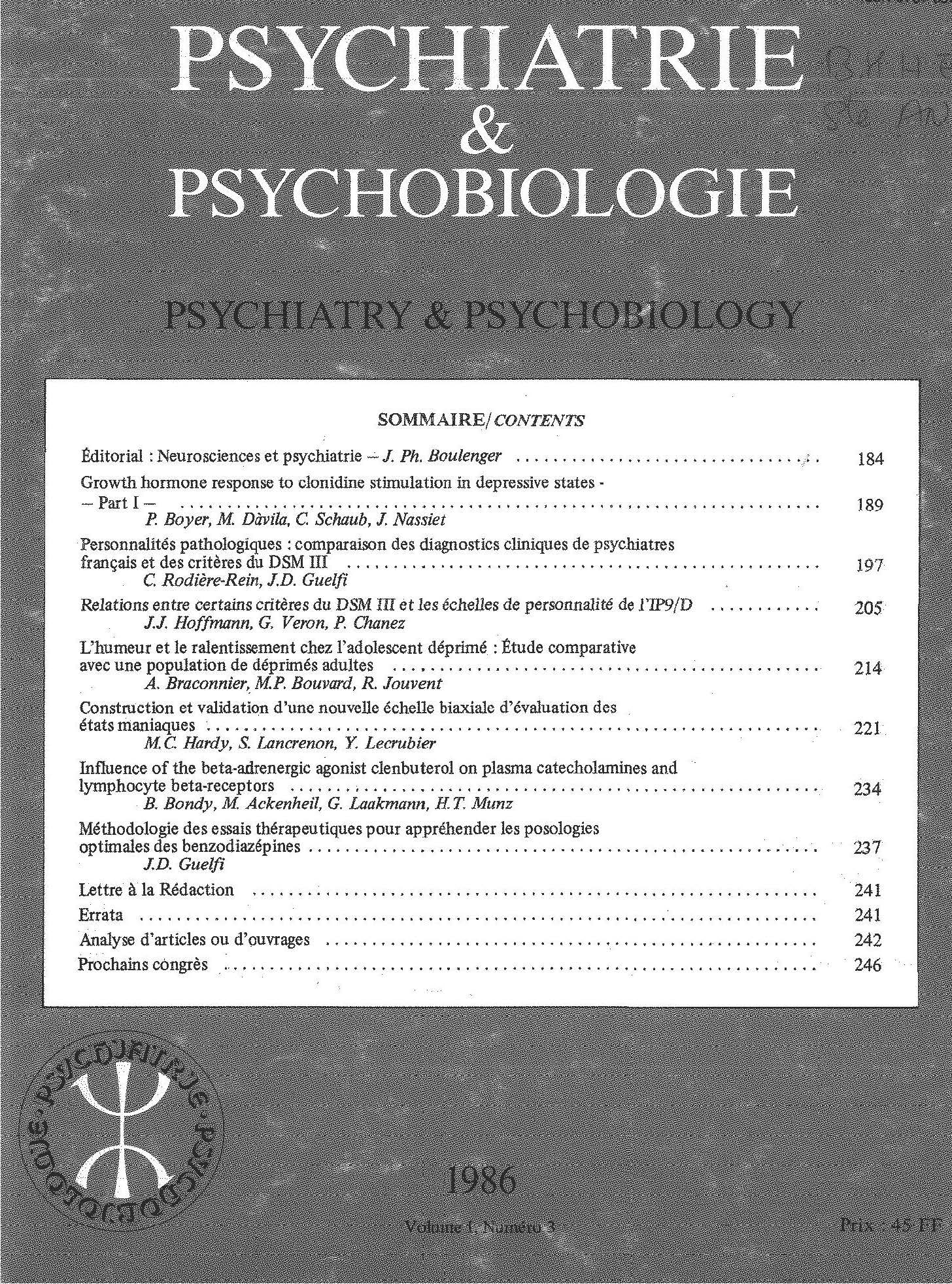Article contents
Growth hormone response to clonidine stimulation in depressive states — First part of a two-part study —
Published online by Cambridge University Press: 28 April 2020
Summary
31 patients presenting a Major Depressive Episode were divided into two groups (endogenous versus neurotic depression), in keeping with the Newcastle criteria (Garside and Roth, 1974). 10 patients were allocated to each group for the realization of a test of growth hormone (GH) response to clonidine stimulation.
The patients received no psychotropes for 8 days prior to the test. Mean age for the neurotic and endogenous groups was respectively 36.67 ± 3.18 years and 44.71 ± 2.56 years. Severity of depression, assessed with the Hamilton rating scale (21 items), was comparable in the two groups (35.35 ± 4.12 versus 39.8 ± 6.13).
The test was carried out in two phases in each patient. During the initial phase, saline was infused over 10 minutes and continuous sampling was realized over a 4-hour period (automatic fraction collector with peristaltic pump), at between 9 AM and 1 PM. 48 hours later, the same procedure was repeated with the addition of 15 µg clonidine. This procedure allowed partial neutralization, for interpretation of results, of the «test apprehension» effect. Assays were carried out by radioimmunoassay (pooled samples), and correspond to real values for 10-minute time intervals (integrated values).
Spontaneous GH secretion in the endogenous group was significantly lower (0.57 ± 0.16 ng/ml) than in the neurotic group (5.03 ± 1.08 ng/ml) and the control group (2.47 ± 0.78 ng/ml). After clonidine stimulation, GH response in the neurotic group was identical to that in the control group. No significant response was observed in the endogenous group. These results confirm those of several previous studies (Matussek, Charney, Checkley, Boyer, Corn, Siever) and seem to indicate hyposensitivity of the post-synaptic α2-adrenergic receptors in endogenous depression. Nevertheless, spontaneous GH hyposecretion in the same patients necessarily involves other mechanisms. The hypotheses concerning these mechanisms will be discussed in the second part of this study.
Résumé
31 patients présentant un épisode dépressif majeur ont été répartis en deux groupes (endogène vs réactionnel-névrotique) selon les critéres de Newcastle (Garside et Roth, 1974), 10patients ont été retenus dans chaque groupe pour réalisation d'une épreuve de stimulation de la sécrétion d'hormone de croissance (GH) par la clonidine.
Les sujets étaient sevrés de tout psychotrope depuis 8 jours. La moyenne d'âge du groupe des dépressions névrotiques était de 36.67 ± 3.18 ans ; celle des dépressions endogènes de 44.71 ± 2.56 ans, L'intensité de l'état dépressif apprécié par l’échelle de dépression de Hamilton (21 items) était comparable dans les deux groupes (35.35 ± 4.12 vs 39.8 ± 6.13).
Pour chaque patient l’épreuve a été réalisée en deux temps, Dans un premier temps une perfusion de sérum salé était administrée en 10 mn et un prélèvement continu de 4 heures (collecteur de fraction avec pompe asservie) était réalisé entre 9 h et 13 h. 48 heures après, la même procédure était répétée avec adjonction de 150μg de clonidine. Cette procédure permettait de neutraliser en partie, dans l’interprétation des résultats, l’effet «appréhension de l'épreuve». Les dosages ont été effectués par radioimmunoassay («poolage” des prélèvements) et correspondent à des valeurs réelles pour des intervalles de temps de 10 mn (valeurs intégrées).
La sécrétion spontanée de GH dans le groupe endogène est significativement plus basse (0.57 ± 0.16 ng/ml) que dans les groupes névrotique (5.03 ± 1.08 ng/ml) et contrôle(2.47 ± 0.78 ng/ml). Après une stimulation par la clonidine, la réponse GH dans le groupe des dépressions névrotiques est identique à celle du groupe contrôle. Aucune réponse significative n’est observée dans le groupe des dépressions endogènes. Ces résultats confirment ceux de plusieurs études antérieures (Matussek, Charney, Checkley, Boyer, Corn, Siever) et semblent en faveur d'une hyposensibilité des récepteurs α2-adrénergiques post-synaptiques dans les dépressions endogènes. Néanmoins, d’autres mécanismes doivent être impliqués dans l’hyposécrétion spontanée de GH chez les mêmes patients. Les hypothèses concernant ces mécanismes seront discutées dans la deuxième partie de ce travail.
Keywords
- Type
- Research Article
- Information
- Copyright
- Copyright © European Psychiatric Association 1986
References
References/Bibliographie
- 10
- Cited by



Comments
No Comments have been published for this article.